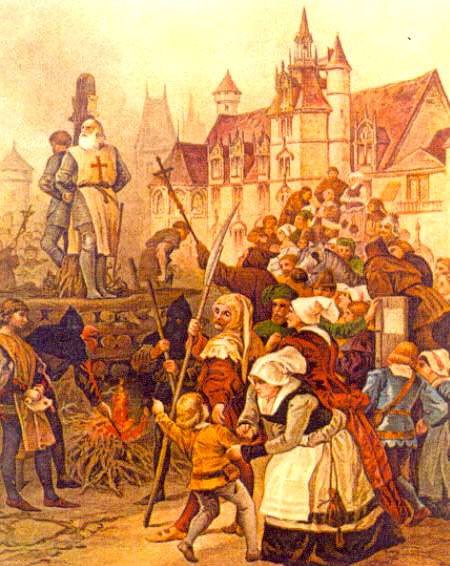 Geoffroi de Gonneville (born c. 1260) was the Knights Templar Preceptor of Aquitaine and Poitou at the time of the infamous arrests. He was imprisoned along with four other dignitaries of the Order, including the Grand Master, Jacques de Molay.
Geoffroi de Gonneville (born c. 1260) was the Knights Templar Preceptor of Aquitaine and Poitou at the time of the infamous arrests. He was imprisoned along with four other dignitaries of the Order, including the Grand Master, Jacques de Molay.
Ivy-Stevan Guiho makes a surprising statement about Geoffroi de Gonneville in his L’Ordre des Templiers: Petite encyclopédie: “De même que Jacques de Molay, il se rétracta au dernier moment et fut brûlé comme relaps” (Just as Jacques de Mollay, he recanted at the last moment and was burnt at the stake as a relapsed heretic). This is a very strange assertion, especially because elsewhere in the book Guiho identifies Geoffroi de Charney as the only other Templar who was burnt at the stake at the same time as Jacques de Molay.
Regardless of this confusion, Geoffroi de Gonneville was an interesting character. While most Templars simply admitted to various charges (under torture and fear of torture), de Gonneville attempted to offer different explanations for “irregularities” in the Knights Templar initiation procedures. He said that, according to rumors, a certain Grand Master who had been held captive by the Saracines had to incorporate a foreshadowing hint of similar treatment into the Order’s initiation ceremony, that being a condition for his release. De Gonneville’s second guess was that brother Roncelin (presumably, Roncelin de Fos) may have introduced corruption into the Order’s life. Or it may also have been Grand Master Thomas Berard who was responsible for incriminating practices. Finally, de Gonneville surmised that denials of Christ were committed in imitation or remembrance of St Peter, who thrice denied his Savior (hoc fit ad instar seu ad memoriam beati petri qui abnegavit Christum ter). In other words, the Templars were admitting crimes against religion without having a good idea of why and what they were doing.
Most curiously, there is a legend, according to which Geoffroi de Gonneville escaped the fortress of Chinon and organized some sort of Templar underground movement. This seems very unlikely, because sources clearly indicate that de Gonneville was indeed transferred to Paris and was among the four Templar dignitaries who were sentenced on March 18, 1314. It is interesting, however, that Raymbaud de Caron who was present and testified at Chinon never made it to Paris! Presumably, he died, but if you want to come up with your own story of the Order’s survival, de Caron could very easily lead the charge 🙂 I wonder it there are theories that include him such a capacity.
To conclude, there is really no reason to suspect that anything different ever happened to Geoffroi de Gonneville beyond what the most trusted source on the final day of Jacques de Molay has to say: Duo vero reliqui adjurato sibi carceri sunt reclusi – “The remaining two were again placed in a cell, according to their charges” (Continuatio chronici Guillelmi de Nangiaco, 1843, p. 204).
P.S. By the way, the illustration above is grossly inaccurate. By the time of de Molay’s execution he would not have worn armor for at least seven years. But I take it as a symbolic representation of the Grand Master’s spiritual state at the time of his execution: he was a proud Knight of the Temple.


0 comments… add one